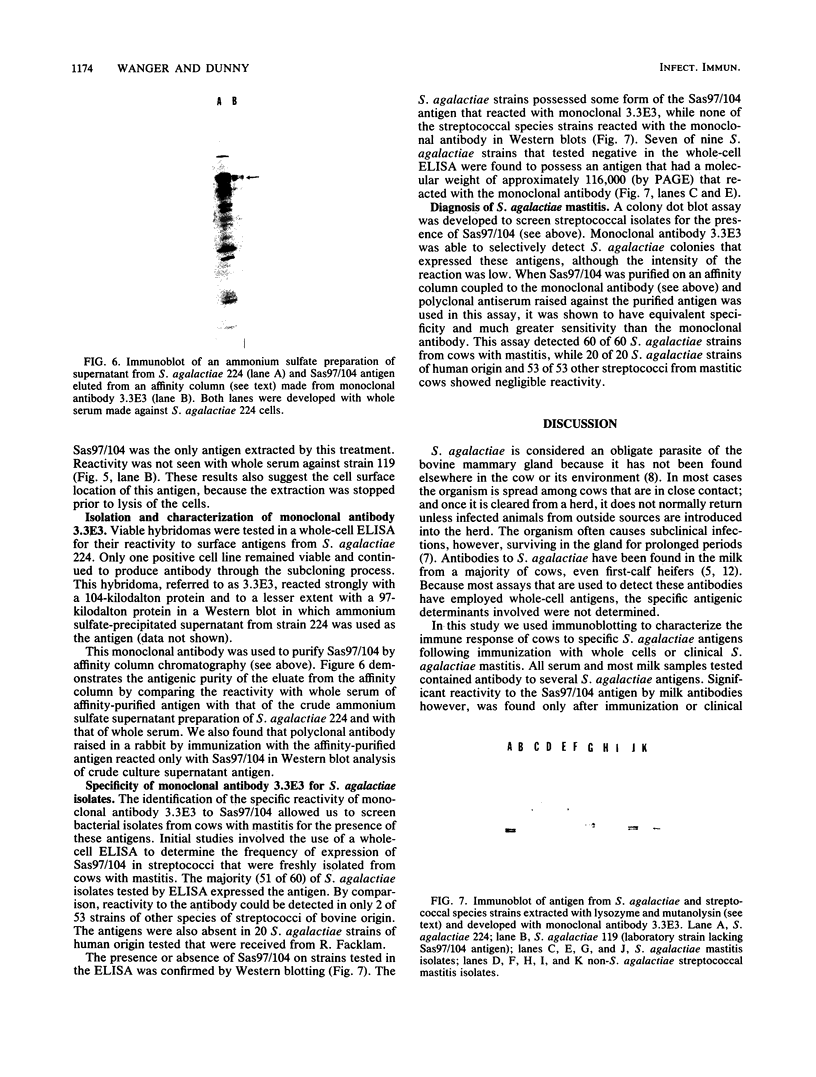Abstract
Immunoblotting was used to analyze the immune response of cows to Streptococcus agalactiae. Antibody from the milk of cows immunized (via the superficial inguinal lymph node) with formalinized S. agalactiae cells or from the milk of cows with S. agalactiae mastitis reacted strongly with a group of high-molecular-weight proteinaceous antigens. The two most predominant antigenic polypeptides in this group had apparent molecular weights of 97,000 and 104,000. Because the data indicated that these two antigens, as well as several minor antigens sometimes observed in the 70- to 100-kilodalton size range, seemed to be different forms of the same protein, we refer to the entire group as Sas97/104. A monoclonal antibody that was reactive with Sas97/104 was derived and was used to purify the antigen by affinity chromatography. Whole-cell and colony blot enzyme-linked immunoassays with either the monoclonal antibody or a polyclonal serum sample raised against the affinity-purified antigen indicated that this antigen (or cross-reactive proteins with higher molecular weights) is present on the S. agalactiae strains that were freshly isolated from mastitic cows. However, the antigen was not detected in S. agalactiae of human origin, bovine strains of S. agalactiae maintained for a prolonged period in the laboratory, or other streptococci. The data are consistent with the notion that Sas97/104 is a surface antigen and does not correspond to previously described type-specific antigens of group B streptococci.
Full text
PDF





Images in this article
Selected References
These references are in PubMed. This may not be the complete list of references from this article.
- Anderson J. C., Heneghan D. J. Extrapolation from experimental chronic staphylococcal mastitis in mice to experimental infections in cattle. Br Vet J. 1979 Nov-Dec;135(6):527–535. doi: 10.1016/s0007-1935(17)30005-2. [DOI] [PubMed] [Google Scholar]
- Baker C. J., Kasper D. L. Correlation of maternal antibody deficiency with susceptibility to neonatal group B streptococcal infection. N Engl J Med. 1976 Apr 1;294(14):753–756. doi: 10.1056/NEJM197604012941404. [DOI] [PubMed] [Google Scholar]
- Beachey E. H. Bacterial adherence: adhesin-receptor interactions mediating the attachment of bacteria to mucosal surface. J Infect Dis. 1981 Mar;143(3):325–345. doi: 10.1093/infdis/143.3.325. [DOI] [PubMed] [Google Scholar]
- Chandler R. L. Ultrastructural pathology of mastitis in the mouse. A study of experimental staphylococcal and streptococcal infections. Br J Exp Pathol. 1970 Dec;51(6):639–645. [PMC free article] [PubMed] [Google Scholar]
- Dodd K., Norcross N. L. Group-specific Streptococcus agalactiae antibodies in colostrum of first-calf heifers. Am J Vet Res. 1968 May;29(5):1095–1096. [PubMed] [Google Scholar]
- Galfrè G., Milstein C. Preparation of monoclonal antibodies: strategies and procedures. Methods Enzymol. 1981;73(Pt B):3–46. doi: 10.1016/0076-6879(81)73054-4. [DOI] [PubMed] [Google Scholar]
- Klegerman M. E., Boyer K. M., Papierniak C. K., Levine L., Gotoff S. P. Type-specific capsular antigen is associated with virulence in late-onset group B Streptococcal type III disease. Infect Immun. 1984 Apr;44(1):124–129. doi: 10.1128/iai.44.1.124-129.1984. [DOI] [PMC free article] [PubMed] [Google Scholar]
- Krause D. C., Baseman J. B. Mycoplasma pneumoniae proteins that selectively bind to host cells. Infect Immun. 1982 Jul;37(1):382–386. doi: 10.1128/iai.37.1.382-386.1982. [DOI] [PMC free article] [PubMed] [Google Scholar]
- Laemmli U. K. Cleavage of structural proteins during the assembly of the head of bacteriophage T4. Nature. 1970 Aug 15;227(5259):680–685. doi: 10.1038/227680a0. [DOI] [PubMed] [Google Scholar]
- Logan E. F., Meneely D. J., Mackie D. P. Enzyme-linked immunosorbent assay for Streptococcus agalactiae antibodies in bovine milk. Vet Rec. 1982 Mar 13;110(11):247–249. doi: 10.1136/vr.110.11.247. [DOI] [PubMed] [Google Scholar]
- Paape M. J., Wergin W. P., Guidry A. J., Pearson R. E. Leukocytes--second line of defense against invading mastitis pathogens. J Dairy Sci. 1979 Jan;62(1):135–153. doi: 10.3168/jds.S0022-0302(79)83215-4. [DOI] [PubMed] [Google Scholar]
- Polin R. A., Kennett R. Use of monoclonal antibodies in an enzyme immunoassay for rapid identification of group B Streptococcus types II and III. J Clin Microbiol. 1980 Apr;11(4):332–336. doi: 10.1128/jcm.11.4.332-336.1980. [DOI] [PMC free article] [PubMed] [Google Scholar]
- ROBERTS S. J., HODGES H. C., FINCHER M. G., TEMPLE H. C., BROWN H. L., CHENEY J. B., JOHNSON S. D., LINQUIST W. E., REED F. I., GUTHRIE R. S. STUDIES OF THE STREPTOCOCCUS AGALACTIAE FORM OF MASTITIS IN DAIRY CATTLE. J Am Vet Med Assoc. 1963 Dec 1;143:1193–1201. [PubMed] [Google Scholar]
- Russell-Jones G. J., Gotschlich E. C. Identification of protein antigens of group B streptococci, with special reference to the Ibc antigens. J Exp Med. 1984 Nov 1;160(5):1476–1484. doi: 10.1084/jem.160.5.1476. [DOI] [PMC free article] [PubMed] [Google Scholar]
- Tortorello M. L., Dunny G. M. Identification of multiple cell surface antigens associated with the sex pheromone response of Streptococcus faecalis. J Bacteriol. 1985 Apr;162(1):131–137. doi: 10.1128/jb.162.1.131-137.1985. [DOI] [PMC free article] [PubMed] [Google Scholar]
- Tortorello M., Adsit J., Krug D., Antczak D., Dunny G. Monoclonal antibodies to cell surface antigens involved in sex pheromone induced mating in Streptococcus faecalis. J Gen Microbiol. 1986 Apr;132(4):857–864. doi: 10.1099/00221287-132-4-857. [DOI] [PubMed] [Google Scholar]
- Towbin H., Staehelin T., Gordon J. Electrophoretic transfer of proteins from polyacrylamide gels to nitrocellulose sheets: procedure and some applications. Proc Natl Acad Sci U S A. 1979 Sep;76(9):4350–4354. doi: 10.1073/pnas.76.9.4350. [DOI] [PMC free article] [PubMed] [Google Scholar]
- Wanasinghe D. D. Adherence as a prerequisite for infection of the bovine mammary gland by bacteria. Acta Vet Scand. 1981;22(1):109–117. doi: 10.1186/BF03547212. [DOI] [PMC free article] [PubMed] [Google Scholar]








